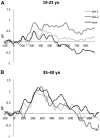Event-related potential index of age-related differences in memory processes in adults with Down syndrome
- PMID: 23993703
- PMCID: PMC3849808
- DOI: 10.1016/j.neurobiolaging.2013.07.024
Event-related potential index of age-related differences in memory processes in adults with Down syndrome
Abstract
A major goal of aging research is to identify early markers of age-related cognitive decline. Persons with Down syndrome (DS) experience accelerated aging and high risks for dementia, making them a valuable albeit understudied model for testing such markers. This study examined event-related potential (ERP) indices of visual memory in younger (19-25 years) and older (35-40 years) adults with DS using a passive viewing paradigm that did not require memorization or behavioral responses. ERPs were recorded in response to unfamiliar urban and nature scenes, with some images presented once and others repeated multiple times. Within 600 to 900 milliseconds after stimulus onset, repeated stimuli elicited more positive amplitudes in younger participants, indicating stimilus recognition. ERPs of older adults did not show such increases, suggesting reduced memory functioning. ERP indices were unrelated to participants' intellectual functioning, but did correlate with age and caregiver-reported lethargy/withdrawal behaviors. Passive ERP measures of memory processes are sensitive to early stages of cognitive decline in DS and are promising markers of cognitive risk for future aging studies.
Keywords: Aging; Down syndrome; ERP; Learning; Memory.
Copyright © 2014 Elsevier Inc. All rights reserved.
Conflict of interest statement
Figures


References
-
- Albert MS, Moss MB, Tanzi R, Jones K. Preclinical prediction of AD using neuropsychological tests. J Int Neuropsychol Soc. 2001;7:631–639. - PubMed
-
- Aman MG, Singh NN. Supplementary Manual. Slosson Educational Publications; East Aurora, NY: 1994. Aberrant Behavior Checklist–Community.
-
- Azimian-Faridani N, Wilding EL. An event-related potential study of the revelation effect. Psychonom Bull Rev. 2004;11:926–931. - PubMed
-
- Azizeh BY, Head E, Ibrahim MA, Torp R, Tenner AJ, Kim RC, Lott IT, Cotman CW. Molecular dating of senile plaques in the brains of individuals with down syndrome and in aged dogs. Experimental Neurology. 2000;163:111–122. - PubMed
-
- Blackwood DH, St Clair DM, Muir WJ, Oliver CJ, Dickens P. The development of Alzheimer's disease in Down's syndrome assessed by auditory event-related potentials. J Ment Defic Res. 1988;32:439–453. - PubMed
Publication types
MeSH terms
Grants and funding
LinkOut - more resources
Full Text Sources
Other Literature Sources
Medical

